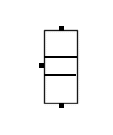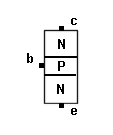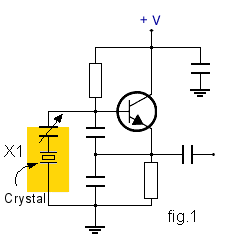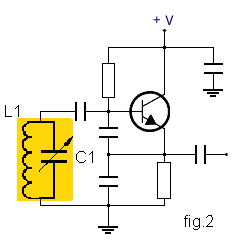|
3. Technical Basics
3i.5 Understand that a transistor is a
three terminal device (emitter, base, collector) in which a
small base current will control a larger collector current
and this enables the transistor to be used as an amplifier.
Understand that the ratio of the
collector current to the base current (IC/IB)
is the current gain  of the transistor. of the transistor.
Note: the student is not required to
recall transistor configurations. Circuits shown will be
an npn transistor connected in common emitter mode.
.
Before we go into the syllabus fully we must take moment to
describe what a transistor is and it basic operation.
The
circuit diagram of an NPN transistor is:- 
We
previously discussed the PN junction when we where looking at
diodes.
The
transistor is called a Bipolar transistor it has 2 junctions
and 3 separate connections.

The
transistor has a thin layer of P type material sandwiched
between 2 thicker N type layers hence the name NPN transistor
or bipolar transistor.

The
layer which forms the middle of the sandwich is called the
BASE, the others are called EMITTER and COLLECTOR
respectively.
 The arrowhead points in the conventional
direction of current flow. The arrowhead points in the conventional
direction of current flow.
The
transistor like the diode need forward bias to turn the
transistor on and then the main current will flow through the
transistor from the collector to emitter .
NPN
transistor used as an AUDIO amplifier

Transistor biased on by R1/R2. To compensate for changes in:
-
operating voltage (battery equipment, batteries getting
tired)
-
variations in operating temperature
-
variations in transistor specifications (even from the
same batch).
Then
R4 is used to provide 100% negative feed feedback at DC. The
reason this works, is because if the transistor takes more
collector current, then this current passes through R4, and a
bigger voltage would appear across it as a result. This
voltage opposes the bias voltage that is set by R1/R2, and
thereby stabilizes the transistor against changes as in 1) to
3) above.
3i.6 Understand that if the variation
in the base current is large enough the collector current
can be turned on and off and the transistor behaves as a
switch.
NPN transistor used as a switch
|

|

|
|
In this configuration when the link is made between
R1 and 9V the LED on.
This is because the current can flow from 9v through
the resistor R2 and the LED through the transistor
to ground.
|
When the
link is made between R1 and 9V the LED is turned off.
This is because the transistors turns on and makes
the collector to R2 link the same potential as
ground and the LED has no current flowing as it all
flows through the transistor (the easier path).
|
Here, we are not concerned with amplification of a signal such
that we want a faithful (and larger) reproduction of the
signal on the output of the transistor. We need DC stability
(i.e. the transistor should stay "off" when intended, and not
be affected by transistor type variations, temperature, or
supply voltage). We also need the transistor to turn fully
"ON", again not affected by the above variations.
This
is fortunately simple; we have only to ensure that there is a
resistor connected between base and emitter (R3) to ensure it
is held "OFF", and then apply, via a resistor (R1), some
current to the base. What we apply needs to be enough to
ensure that the transistor is fully turned on despite
variations as above, and also be enough to allow some to go
through R3, (This resistor "nicks" it from the transistor!).
The on and off concept according to the configuration.
Ask
your tutor to build a small circuit based upon the above so
that you can see the difference between the two circuits in
that sometime applying a current to the base turns the led on
and sometimes it is the other way round that applying a
current turns the led off.
 Whilst not part of the syllabus you might like to know that
the other type of transistor is a PNP transistor has a thin
layer of N type material sandwiched between 2 thicker P type
Layers. The arrowhead on the emitter symbol distinguishes the
transistor as being either NPN or PNP.
Whilst not part of the syllabus you might like to know that
the other type of transistor is a PNP transistor has a thin
layer of N type material sandwiched between 2 thicker P type
Layers. The arrowhead on the emitter symbol distinguishes the
transistor as being either NPN or PNP.
Understand that the ratio of the collector
current to the base current (IC/IB
of the transistor.
A
Transistor is a current amplifying device.  is the DC current gain of a transistor
in common emitter mode PNP or NPN transistor If the current on
the base of the transistor is Ib and the collector current is
Ic is the DC current gain of a transistor
in common emitter mode PNP or NPN transistor If the current on
the base of the transistor is Ib and the collector current is
Ic
 = Ic /Ib = Ic /Ib
So
if the base current Ib is 10uA and the collector current Ic is
1mA
Beta
= 1mA/10uA = 100
If
transistor has a Beta of 200 and the bases current Ib is 100uA
then the collector current would be 200 times greater
or  x Ib 200 x 100uA = 20mA x Ib 200 x 100uA = 20mA
3i.7 Recall that a transistor must be
provided with the correct DC voltages and currents to allow
it to function and that this is termed correct biasing.
Note that calculations are not required.
For
a transistor to work correctly as an amplifier the correct
proper potential voltage must be present on base, collector
and emitter so the transistor is biased to achieved this.
Normally the term bias refers to the voltage applied to the
base to bring the operating point to a linear part of the
transistor amplification curve . For a Germanium transistor a
voltage between emitter and base of 0.3 volts and for a
silicon transistor 0.6 volts.
3i.8 Recall
that a transistor can be used to generate audio and radio
frequencies by maintaining the oscillations in a tuned or
frequency selective circuit.
A
simple fact to be recalled is that a transistor can be used as
an oscillator to generate audio and radio frequencies.
The
sort of question you might be asked in this section is what
can a transistor be used for of which 3 will be spoof answers.
Distinguish between a crystal oscillator and
a variable frequency oscillator (VFO) based on a tuned
circuit.
Diagrams will show the Colpitts
oscillator with the transistor in emitter follower mode.
Students are not expected to recognise other types of
oscillator.
 
The
above are not practical circuits as no off bias exists to the
transistor BUT the important parts to recognise are those
that have been highlighted.
The
diagram fig.1 on the left shows a crystal and thus is a fixed
frequency Crystal Oscillator. Do not be confused with the
variable capacitor into thinking that it is a variable
oscillator as the variable capacitor is there to bring the
crystal oscillator to resonance at a particular frequency.
sometime the variable capacitor is not even in the circuit.
The
diagram fig.2 on the right shows a tuned circuit highlighted
and also shows a variable capacitor in parallel with an
inductor, making up the tuned circuit, and thus is a variable
frequency oscillator.
 Lossy: You put some in, and don't
get it all back out! The transistor amplifier only has enough
gain to make the circuit oscillate when the coil and capacitor
are not "lossy" (i.e resonant), it oscillates at one
frequency. Lossy: You put some in, and don't
get it all back out! The transistor amplifier only has enough
gain to make the circuit oscillate when the coil and capacitor
are not "lossy" (i.e resonant), it oscillates at one
frequency.
 Gain: The
ability of the circuit to take a small signal, and make it
bigger. Gain: The
ability of the circuit to take a small signal, and make it
bigger.
The
advantage of using a coil and a capacitor to determine the
required frequency is that either component may be varied to
alter the frequency. It is not difficult to alter these
components, and variable types are available. The down side of
doing so is that a number of things (like a change in
temperature) can cause the actual value of the coil, or the
capacitor to vary, and as a result, the frequency changes.
 Using a crystal to determine the frequency as in fig 1 (X1)
will result in a very stable oscillator, but it is very
difficult to alter the frequency, even by a very small amount.
Some years back, in order to have a stable frequency in VHF
radios, crystals were used in both the transmitter and
receiver to determine the operating frequency. Unfortunately,
to change channel, you switched in a different pair of
crystals. This was expensive, (£10 a channel or so!). We
didn't have too many channels available in those days!
Using a crystal to determine the frequency as in fig 1 (X1)
will result in a very stable oscillator, but it is very
difficult to alter the frequency, even by a very small amount.
Some years back, in order to have a stable frequency in VHF
radios, crystals were used in both the transmitter and
receiver to determine the operating frequency. Unfortunately,
to change channel, you switched in a different pair of
crystals. This was expensive, (£10 a channel or so!). We
didn't have too many channels available in those days!
 Frequency of a crystal: Think of a crystal as being similar in
a way to when you sing in the bath! You will notice that
certain notes you sing are a lot louder than others, and in
fact, at audio frequencies, the bathroom (being generally a
small, unfurnished room) resonates at particular frequencies.
Just as it is not easy to alter that by changing the size of
the room, you would need to physically grind the crystal to
make it thinner to alter the frequency it works on (very hard,
but it can be done, and the frequency would increase), or make
it bigger to get the frequency down (impossible!).
Frequency of a crystal: Think of a crystal as being similar in
a way to when you sing in the bath! You will notice that
certain notes you sing are a lot louder than others, and in
fact, at audio frequencies, the bathroom (being generally a
small, unfurnished room) resonates at particular frequencies.
Just as it is not easy to alter that by changing the size of
the room, you would need to physically grind the crystal to
make it thinner to alter the frequency it works on (very hard,
but it can be done, and the frequency would increase), or make
it bigger to get the frequency down (impossible!).
|